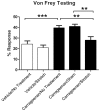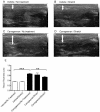Stretching of the back improves gait, mechanical sensitivity and connective tissue inflammation in a rodent model
- PMID: 22238664
- PMCID: PMC3253101
- DOI: 10.1371/journal.pone.0029831
Stretching of the back improves gait, mechanical sensitivity and connective tissue inflammation in a rodent model
Abstract
The role played by nonspecialized connective tissues in chronic non-specific low back pain is not well understood. In a recent ultrasound study, human subjects with chronic low back pain had altered connective tissue structure compared to human subjects without low back pain, suggesting the presence of inflammation and/or fibrosis in the low back pain subjects. Mechanical input in the form of static tissue stretch has been shown in vitro and in vivo to have anti-inflammatory and anti-fibrotic effects. To better understand the pathophysiology of lumbar nonspecialized connective tissue as well as potential mechanisms underlying therapeutic effects of tissue stretch, we developed a carrageenan-induced inflammation model in the low back of a rodent. Induction of inflammation in the lumbar connective tissues resulted in altered gait, increased mechanical sensitivity of the tissues of the low back, and local macrophage infiltration. Mechanical input was then applied to this model as in vivo tissue stretch for 10 minutes twice a day for 12 days. In vivo tissue stretch mitigated the inflammation-induced changes leading to restored stride length and intrastep distance, decreased mechanical sensitivity of the back and reduced macrophage expression in the nonspecialized connective tissues of the low back. This study highlights the need for further investigation into the contribution of connective tissue to low back pain and the need for a better understanding of how interventions involving mechanical stretch could provide maximal therapeutic benefit. This tissue stretch research is relevant to body-based treatments such as yoga or massage, and to some stretch techniques used with physical therapy.
Conflict of interest statement
Figures





Similar articles
-
Stretching Impacts Inflammation Resolution in Connective Tissue.J Cell Physiol. 2016 Jul;231(7):1621-7. doi: 10.1002/jcp.25263. Epub 2015 Dec 10. J Cell Physiol. 2016. PMID: 26588184 Free PMC article.
-
Establishment of a Novel Porcine Model to Study the Impact of Active Stretching on a Local Carrageenan-Induced Inflammation.Am J Phys Med Rehabil. 2020 Nov;99(11):1012-1019. doi: 10.1097/PHM.0000000000001465. Am J Phys Med Rehabil. 2020. PMID: 32427602 Free PMC article.
-
[The Therapeutic Effect and Mechanism of Static Progressive Stretching in Different Durations on Traumatic Knee Contracture in Rats].Sichuan Da Xue Xue Bao Yi Xue Ban. 2020 Mar;51(2):185-192. doi: 10.12182/20200360204. Sichuan Da Xue Xue Bao Yi Xue Ban. 2020. PMID: 32220186 Chinese.
-
Yoga compared to non-exercise or physical therapy exercise on pain, disability, and quality of life for patients with chronic low back pain: A systematic review and meta-analysis of randomized controlled trials.PLoS One. 2020 Sep 1;15(9):e0238544. doi: 10.1371/journal.pone.0238544. eCollection 2020. PLoS One. 2020. PMID: 32870936 Free PMC article.
-
The biomechanical mechanism of how strength and power training improves walking speed in old adults remains unknown.Ageing Res Rev. 2013 Mar;12(2):618-27. doi: 10.1016/j.arr.2013.03.001. Epub 2013 Mar 15. Ageing Res Rev. 2013. PMID: 23501431 Review.
Cited by
-
Mechanisms Underlying Anti-Inflammatory and Anti-Cancer Properties of Stretching-A Review.Int J Mol Sci. 2022 Sep 4;23(17):10127. doi: 10.3390/ijms231710127. Int J Mol Sci. 2022. PMID: 36077525 Free PMC article. Review.
-
THE CONSTRAINING EFFECT OF THE LATERAL FEMORAL INTERMUSCULAR SEPTUM ON PASSIVE HIP ADDUCTION IN UN-EMBALMED CADAVERS.Int J Sports Phys Ther. 2020 Feb;15(1):42-52. Int J Sports Phys Ther. 2020. PMID: 32089957 Free PMC article.
-
Yoga for Heart Failure: A Review and Future Research.Int J Yoga. 2018 May-Aug;11(2):91-98. doi: 10.4103/ijoy.IJOY_24_17. Int J Yoga. 2018. PMID: 29755216 Free PMC article. Review.
-
Clinical Impact of Thermotherapy and Spinal Twisting Massage on Chronic Non-Specific Spinal Pain.Medicina (Kaunas). 2024 Jun 13;60(6):976. doi: 10.3390/medicina60060976. Medicina (Kaunas). 2024. PMID: 38929593 Free PMC article.
-
A systematic review of in vivo stretching regimens on inflammation and its relevance to translational yoga research.PLoS One. 2022 Jun 1;17(6):e0269300. doi: 10.1371/journal.pone.0269300. eCollection 2022. PLoS One. 2022. PMID: 35648793 Free PMC article.
References
-
- Yuktasir B, Kaya F. Investigation into the long-term effects of static and PNF stretching exercises on range of motion and jump performance. J Bodyw Mov Ther. 2009;13:11–21. - PubMed
-
- Chen CH, Nosaka K, Chen HL, Lin MJ, Tseng KW, et al. Effects of Flexibility Training On Eccentric Exercise-Induced Muscle Damage. Med Sci Sports Exerc 2010 - PubMed
-
- Sherman KJ, Cherkin DC, Erro J, Miglioretti DL, Deyo RA. Comparing Yoga, Exercise, and a Self-Care Book for Chronic Low Back Pain: A Randomized, Controlled Trial. Ann Intern Med. 2005;143:849–856. - PubMed
-
- Williams KA, Petronis J, Smith D, Goodrich D, Wu J, et al. Effect of Iyengar yoga therapy for chronic low back pain. Pain. 2005;115:107–117. - PubMed
Publication types
MeSH terms
Grants and funding
LinkOut - more resources
Full Text Sources
Medical

